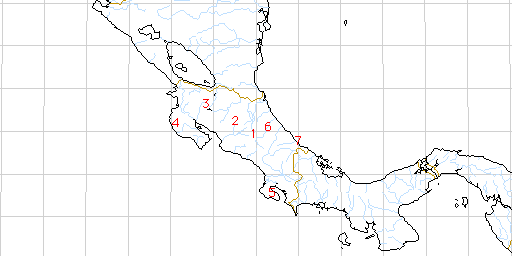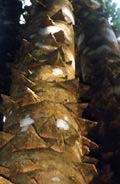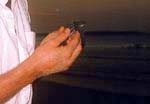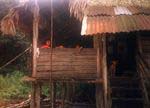Costa Rica, Feb. 1997
Duration: 3 weeks
Notes for the traveler:
Costa Rica is quite a small country (about the size of West
Virginia), but has a remarkable variety of climatic
zones: cloud forest, rain forest, arid scrubland, swamp,
beaches...Some areas were cool and pleasant during our trip, others
were hot and muggy. If you're traveling through the whole country,
expect variety.
Costa Rica has set aside a large fraction of the country (about
30%) in nature preserves, though enforcement is spotty.
Compared to other Central American countries, Costa Rica is
relatively wealthy and developed. Most people can read and write,
the phones work, you can drink the water (or at least brush your
teeth with it), the main roads are decent (though often slow because
of ponderous trucks), buses run on time, and hotel reservations
are taken and respected. Most people speak some English, so it's
easy to get around as a tourist, though as always people appreciated
it when we tried to speak their language.
On the other hand, minor roads are often quite bad, and even
the main roads are usually just one lane with no shoulder, so
travel can be very slow indeed. E.g., from San Jose to Puerto
Jimenez (on the Ossa peninsula, on the way to Corcovado National
Park), a distance of 200 miles as the crow flies, took 9 hot and
uncomfortable hours on a non-stop bus. From there, it was another
hour by chartered taxi to our lodging outside Corcovado. Consider
flying.
Most inexpensive hotels have no hot water, though some have
ineffective heaters to provide lukewarm water.
Food is usually simple, and can be boring. There is little
variety. The national dish is "gallo pinto", a mixture
of rice and beans with some very mild spices. Fruit is often available---rinse
it, and eat it without worries.
Prices are considerably lower than in the U.S., but not dirt
cheap. In 1997, we paid $15 or more for a decent hotel, and $4-$8
for a typical dinner. Figure about 1/2 of the U.S. rate (though
the dollar may be stronger now).

Our trip included:
- 1. A few days in the capital, San
Jose
- Most guides to Costa Rica suggest getting away from San Jose
as quickly as possible. I'm inclined to agree. There are a few
museums (the Gold Museum is supposed to be interesting, though
we didn't go), and we spent an interesting day wandering through
the farmers' market and walking around the city, but given all
of the great things to do in the country it's hard to see why
you would spend much time here. If you do find yourself in the
city for a couple of days, we highly recommend the "Hotel
Grano de Oro", which was very comfortable, friendly, and
pleasant, if rather pricey by Costa Rican standards.
-
- 2. Monte Verde cloud forest
- Our introduction to wet tropical forest. We took a guided
day tour along well-maintained trails...a guide is definitely
worth it, at least for your first outing: if we'd been on our
own, we wouldn't have known where to look, what to look for,
or how to identify and interpret what we saw. And what we saw
included rare and impressive "Quetzal" birds, a sloth,
and howler monkeys, in addition to the more usual carpenter ants,
strangler figs, hummingbirds, etc. Normally, one is allowed to
camp overnight only at a hut far into the forest; unfortunately
that trail was closed due to a mudslide while we were there.
-
- It's not just the insects and animals that differ greatly
from what we're used to in the U.S.---many of the plants and
trees are also remarkable. Giant strangler figs are particularly
impressive: their seeds are deposited by birds high in the branches,
where
 the
plants start taking their nourishment mostly from the air. They
send out roots that slowly wind their way down and around their
host tree, eventually reaching the ground. Finally able to draw
nutrients from the soil, they continue to grow, both upwards
and in width, until eventually they engulf the tree in a web
of roots and branches. The tree then dies, both from being shaded
out and from the strangler's constrictive pressure on its outer
layers. Eventually the host tree decays completely, leaving a
huge, hollow strangler fig in its place.
the
plants start taking their nourishment mostly from the air. They
send out roots that slowly wind their way down and around their
host tree, eventually reaching the ground. Finally able to draw
nutrients from the soil, they continue to grow, both upwards
and in width, until eventually they engulf the tree in a web
of roots and branches. The tree then dies, both from being shaded
out and from the strangler's constrictive pressure on its outer
layers. Eventually the host tree decays completely, leaving a
huge, hollow strangler fig in its place.
-
- Other trees are also interesting, like the one shown at right,
which has spikes (presumably evolved to discourage animals from
climbing it) all around the trunk.
-
- Also in this area, we hiked around a private nature preserve
(where we saw a tapir, among other things), visited a butterfly
farm, and took a "canopy tour" that featured climbing
up the inside of a huge, hollow strangler fig tree and zipping
between two elevated platforms along a cable. We also found a
scorpion in our shower one night!
-
- 3. Rincon de la Vieja volcano
- Interesting hiking through dry tropical forest and grassland,
and dramatic scenery as we climbed the flanks of the volcano.
After a hot, somewhat difficult climb through dry grasslands
against very strong headwinds, we cooled off in a warm pool under
a waterfall. We then descended (having been told that the all-day
hike to the summit isn't worth it, since often there's nothing
even visible because of heavy fog). After the descent, we hiked
over to yet another pool under a waterfall...this one much bigger
(both the pool and the impressive waterfall), and with warm water
issuing from rocks off to one side. Finally we hiked back through
a stretch of forest, where we saw a family of comical-looking
coatimundis hussling across the road.
-
- 4. Playa Grande---sea
turtles
 This
beach is a nesting area for sea turtles (there's also one on
the Caribbean coast, Toruguero, which we did not go to). At Playa
Grande, the beach is closed during the night but guides take
people out to see the female turtles come ashore and lay their
eggs. (The guides are some of the same people who used to raid
the nests for eggs, which were used in the local cookie factory,
as recently as 10 years ago). No females came ashore the night
we were there, which was at the end of the season, but we did
go out early in the morning and find a nest that had "broken"
during the night. The eggs all hatch at about the same time,
and the baby turtles, which are just a few inches long, all work
their way up to just below the surface. Then, when the night-time
temperature falls low enough, they climb out and head for the
sea (attracted by the whitish color of the foam---they will head
towards any light, so lights from towns or hotels along the beach
can make them crawl the wrong way, fatally). Usually, some of
the baby turtles that started out deep in the nest aren't able
to make it out at night. These will be dug out and eaten during
the day by birds and other predators, which are able to find
the nest easily once all of the other turtles climb out of it.
This
beach is a nesting area for sea turtles (there's also one on
the Caribbean coast, Toruguero, which we did not go to). At Playa
Grande, the beach is closed during the night but guides take
people out to see the female turtles come ashore and lay their
eggs. (The guides are some of the same people who used to raid
the nests for eggs, which were used in the local cookie factory,
as recently as 10 years ago). No females came ashore the night
we were there, which was at the end of the season, but we did
go out early in the morning and find a nest that had "broken"
during the night. The eggs all hatch at about the same time,
and the baby turtles, which are just a few inches long, all work
their way up to just below the surface. Then, when the night-time
temperature falls low enough, they climb out and head for the
sea (attracted by the whitish color of the foam---they will head
towards any light, so lights from towns or hotels along the beach
can make them crawl the wrong way, fatally). Usually, some of
the baby turtles that started out deep in the nest aren't able
to make it out at night. These will be dug out and eaten during
the day by birds and other predators, which are able to find
the nest easily once all of the other turtles climb out of it.
-
- According to the nearby turtle museum (which has an unspectacular
but very interesting display on the life cycle of the sea turtle),
once the nest has hatched, it's OK to dig out the otherwise-doomed
turtles that didn't make it during the night, and take them to
the sea and give them a chance. We tried this with about 4 or
5 of them, but, sad to say, birds snatched them all up out of
the ocean within a few minutes. Depressing, but part of the normal
cycle.
-
- 5. Corcovado National Park---rainforest
- We stayed for several days at the edge of this large and
fairly remote rainforest, where we saw three kinds of monkeys:
howler monkeys, spider monkeys, and white-faced
capuchins. Also a flock of colorful (and raucous) macaws,
a "flock" of bats that formed their own bat-house from
a palm leaf, and a fer-de-lance snake (most poisonous in Central
America). Plus many interesting trees, insects, etc., including
a flying beetle the size of a hen's egg that landed on a lodge-worker's
hand; after it dug its legs in when someone tried to remove it,
the worker said "no moleste mas"---"don't bother
it anymore", and just left it there until it flew away.
As at Monte Verde, we did a day hike with a guide, and definitely
recommend it. We also did an all-day trek up a river, a relatively
easy way to cover a fair amount of territory.
-
- We also did a 2-hour horseback ride...my horse was so small,
I felt sorry for it. (I also discovered that the leg position
for horseback riding was very painful to my knee).
-
- The western edge of Corcovado is on the Pacific, and has
beautiful beaches with excellent (though sometimes dangerous)
body-surfing.
-
- 6. Turrialba area---rafting
on the Pacuare River
- We did a 1-day raft trip on the beautiful Pacuare River.
The water was pretty low, so we had a relatively calm ride, though
the guide did a good job turning even tame rapids into an adventure
by choosing exciting routes when possible. The scenery was great.
We saw a small amount of wildlife, including an eagle and a poison-arrow
frog.
-
- There is a plan to dam the Pacuare and flood everything that
we saw...a tough issue, since the country certainly needs power
and hydro is one of their only resources; but nature tourism
is a major industry. I'd hate to see them dam the Pacuare, but
it's hard to be critical from here in the resource-rich, dam-happy
United States.
-
- We stayed for one night at the "Turrialtico Lodge",
a great location on the top of a promontory overlooking the valley
below. After we went to bed, Alec Baldwin dropped in for drinks...with
a woman who wasn't his wife. They apparently were staying
at the very ritzy hotel in the valley, right in the middle of
a big sugar cane field, where we ended up staying for a night
at the end of our trip, on the way back from the Caribbean. It
was indeed nice, but when we jogged a few miles down the road
to use the tennis courts in a small enclave of houses belonging
to the owners of the adjacent cane processing plant, we had to
stop playing after a short while: the air pollution was unbelievable.
Our hands (and the ball) turned black from the ash in the air
and on the court.
-
- Also in this area, we visited a macadamia nut farm/processing
plant, where the foreman showed us around for a small fee, and
sent us off with a big bag of nuts.
-
 Leaving the area
on our way to the Caribbean, we had just passed a truck on a
long uphill, when we came around a bend and saw a sloth crawling
(very, very slowly) across the road! We pulled over quickly,
and I grabbed the sloth and hustled him off to the edge of the
road before the truck came by. He hissed gently at me and moved
his arms around slowly. I put him in the grass (not very good
photo at left), and we watched him briefly, but we were worried
(probably needlessly) that our presence would make him nervous
and lead him to do something bad, so we left. We then worried
about him (her?) for the next several days (should we have carried
him to a tree? What if a dog came along? etc.), until we passed
through again on our way back and saw the track where he had
crawled through the grass, and Juliet eventually spotted him
up in a tree.
Leaving the area
on our way to the Caribbean, we had just passed a truck on a
long uphill, when we came around a bend and saw a sloth crawling
(very, very slowly) across the road! We pulled over quickly,
and I grabbed the sloth and hustled him off to the edge of the
road before the truck came by. He hissed gently at me and moved
his arms around slowly. I put him in the grass (not very good
photo at left), and we watched him briefly, but we were worried
(probably needlessly) that our presence would make him nervous
and lead him to do something bad, so we left. We then worried
about him (her?) for the next several days (should we have carried
him to a tree? What if a dog came along? etc.), until we passed
through again on our way back and saw the track where he had
crawled through the grass, and Juliet eventually spotted him
up in a tree.
-
- 7. Puerto Viejo---Caribbean
coast
- My friend Mark Bertin and his then-girlfriend said the southern
Caribbean coast was the highlight of their Costa Rican trip.
Things here are very different---a black caribbean culture, with
English as the first language.
-
- We were less enchanted by the culture (perhaps because we
didn't experience it so much), but we still enjoyed the area
very much. One day, we (and two other travelers) hired an ex-pat
American hotel owner to show us around. She took us to an iguana
farm, run by assimilated Bri-bri indians, where iguanas are raised
and released to try to again build a wild population, a traditional
source of food.
-
 We
also visited a less-assimilated indian village---a small group
of grass huts, elevated on wooden stilts, where a bunch of indians
were sitting around talking. We bought some of their crafts---a
drinking gourd, and some bows and arrows. I found it all very
interesting. They had just cooked some palm nuts, and gave us
some. We thought they tasted great---reminscent of artichoke
hearts, but with a nuttier, drier texture---and that it's just
a matter of time before they're "discovered" by some
him American restaurant.
We
also visited a less-assimilated indian village---a small group
of grass huts, elevated on wooden stilts, where a bunch of indians
were sitting around talking. We bought some of their crafts---a
drinking gourd, and some bows and arrows. I found it all very
interesting. They had just cooked some palm nuts, and gave us
some. We thought they tasted great---reminscent of artichoke
hearts, but with a nuttier, drier texture---and that it's just
a matter of time before they're "discovered" by some
him American restaurant.
-
- We tried to pay with travelers checks at the small hotel
we were staying at, but the woman there said she didn't want
them. Disappointed, we nearly headed off on a 45-minute trip
to the nearest bank in order to cash them...but then the woman's
brother agreed to cash them for us. It turned out he was the
former president of the country! I told him that we had greatly
enjoyed our visit and that we appreciated the country's efforts
to protect their wildlife and rainforest...and that we hoped
that they wouldn't dam the Pacuare river (see above). He quite
reasonably said that nature is important, but the people need
electricity, and Costa Rica has no oil or coal and they don't
want to go nuclear, so a dam might be necessary.
-

